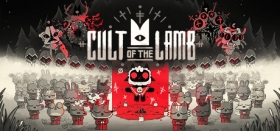
Cult of the Lamb is a Great Amalgamation of Excellent Titles
Cult of the Lamb is a game I've been keeping a close eye on for a while now. The cutesy graphics and appealing gameplay were only accentuated even further by the darker themes that surrounded it; at a glance, you wouldn't be able to tell that Cult of the Lamb has a dark story. In fact, you wouldn't be able to tell a whole lot about the game, but what if I told you that Cult of the Lamb has far more that is recognisable than meets the eye?
Despite the uniqueness of Cult of the Lamb (it's easily the most distinctive title I've played in recent history), a lot of what makes it great is how it perfectly amalgamates things that were already excellent in some other games and builds on them. In fact, it's difficult to find what genre Cult of the Lamb doesn't dabble in, and that's one of the great things about it. So, what will you recognise from Cult of the Lamb, and what did it learn — and oftentimes bettered — from these titles?

The first (and perhaps most obvious) similarity that Cult of the Lamb has to any game is the nearly parallel graphics style to Don't Starve and other titles that have taken to create almost 2D characters in an otherwise 3D world. The likeness between Don't Starve and Cult of the Lamb doesn't end there though, as the animations (such as the Lamb rummaging through berry bushes), darker tones, and decoration that are reminiscent of the former are also present.
Once you start playing, however, more similarities between titles begin to surface; it was immediately noticeable to me how similar (and perfectly) Cult of the Lamb took inspiration from Hades' fighting style. As you unlock more weapons, you eventually unlock the Curse ability; this Curse ability is identical to Zagreus' Cast in Hades. This isn't the only similarity, as the feel of the combat and encounters (including repeating bosses, much like one will face in their journey to escape the Underworld) feel reminiscent of not only Hades but Supergiant Games' other iconic title, Bastion. It's difficult not to want to replay either of these two titles whilst slashing wildly against the non-believers.

The combat aspect slowly felt similar to other great titles I've played in the past too, as the roguelike element (and starting weapons) also felt very similar to those that you can find in Dead Cells. Or, the bosses and grotesque imagery are very similar to what I've seen throughout my playthroughs of Binding of Isaac — especially some bosses that vomit projectiles at the Lamb, which is an attack that immediately reminded me of Binding of Isaac.
It isn't only the graphics and combat gameplay that are reminiscent of other titles, as the building and borderline life simulator aspects of Cult of the Lamb feel like other great titles I've come to know and love. Sprinkle in some Stardew Valley in farming and decoration aspects, Graveyard Keeper with cannibalism and graveyards for your cultists, and even a dice-based board game similar to Farkle from Kingdom Come: Deliverance, and you have a strange fusion of a bunch of great titles.

And best of all? Cult of the Lamb doesn't only mimic the things it sees succeed from others but tries to adapt them in a way that doesn't feel misplaced. Did Cult of the Lamb revolutionise in each of the titles and areas I've mentioned? No, not necessarily, as Zagreus' escape from the Underworld, or Dead Cells' 2D-based, fast-paced combat still remain best-in-class However, Cult of the Lamb tackles these areas with its own spin, making it an excellent title and a powerful contender for one of the best indie games to be released as of yet.








COMMENTS